

 |
 |
Eun-Ok Baek and James Monaghan
California State University San Bernardino, USA
eTextbooks have steadily and recently more rapidly penetrated the textbook market. In order to effectively support students’ learning, it is important to comprehend students’ experiences using eTextbooks. This survey study was designed to gain an understanding of students’ experiences in using eTextbooks and variables that impact their experiences, perceptions, and attitudes towards eTextbooks. In a total of 33 courses, faculty members at five state university campuses in California participated in the eTextbook pilot project during the fall of 2010. Six hundred and sixty-two student questionnaires were returned from those courses. Key findings include: 1) More than one-third of the students were satisfied with the eTextbook; 2) more than half of the students felt that the eTextbook was easy-to-use; 3) older students (22 or older) tended to have more positive experiences with the eTextbook than younger students; and 4) students most liked the eTextbook’s cost, accessibility, light weight, and keyword search features. This study implies that the eTextbook must be a high-quality, easy-to-use resource to serve as a viable textbook option for student learning.
Keywords: Affordable Learning Solutions (ALS); attitudes; digital textbooks; eTextbook; ebook; accessibility; textbook publisher; students’ perceptions; survey; higher education; user satisfaction; ease of use
Various US government reports clearly show that skyrocketing textbook costs threaten the accessibility and affordability of higher education in the United States (Advisory Committee on Student Financial Assistance, 2007; Federal Textbook Price Disclosure Law, 2010; US Government Accountability Office Report on College Textbooks Accountability, 2005). The US Government Accountability Office Report on College Textbooks Accountability (2005) stated that between 1986 and 2004, textbook prices nearly tripled in the United States, increasing at an average of 6% per year, for a total increase of 186%.
Also the Advisory Committee on Student Financial Assistance (2007) reported that textbook prices represent a significant barrier to students’ accessibility to textbooks. The report concluded that textbooks cost between $700-$1000 per year; textbook prices have risen much faster than other commodities; and that college aid fails to cover textbook expenses. Textbook costs are equivalent to 26% of tuition costs for an average four-year public university student and 72% of tuition costs for an average community college student. In fact, the California State Auditor (2008) reported that textbook costs grew more rapidly than student fees in academic year 2007–08.
The federal textbook price disclosure law, issued on July 1, 2010, as a continuation of the Higher Education Opportunity Act of 2008, considers cost an integral part of textbook selection. According to this act, institutions will be required to disclose “to the maximum extent practicable,” textbook information, including cost, in their course schedules during the registration process. Also, it requires the publisher to make available information about copyright dates for the three previous editions, whether or not the textbook is available in any other forms, and the price of the textbook with and without bundled materials (Student PIRG, 2010; US Department of Education, 2008).
Over 30 states introduced legislation related to the textbook issues addressed in the act (West Virginia Higher Education Policy Commission and Community and Technical College System, 2009). Many university systems have initiated projects to offer affordable textbook options such as eTextbooks, textbook rental models, and open textbooks (Hull & Lennie, 2010; Johnson, 2011; Maxwell, Little, & Stites-Doe, 2011; Young, 2010a; Young, 2010c). Issues related to the eTextbook option, the focus of this study, will be discussed in the following section.
eTextbooks became available in the late 1990s with the market gradually growing through 2007 and dramatically increasing since 2008 (Johnson, 2011). eTextbooks have disrupted the traditional higher education textbook market including other alternative textbook options (e.g., textbook rental models and open textbooks) due to their competitive costs (Hull & Lennie, 2010; Johnson, 2011; Maxwell, Little, & Stites-Doe, 2011; Weisberg, 2011; Young, 2010a; Young, 2010c).
A growing number of students are more open to eTextbooks (Maxwell, Little, & Stites-Doe, 2011) for their accessibility, user-friendly interfaces, and cost-effectiveness. This, however, does not necessarily mean that students are ready to adopt eTextbooks. Many studies show that students simply prefer printed books to eTextbooks because of the look and feel (Book Industry Study Group, 2010; NACS, 2010; Young, 2010b) regardless of their gender (McGowan, Stephens, & West, 2009; Woody, Danel, & Baker, 2010), comfort level with computers (Woody et al., 2010), and prior experience using eTextbooks (McGowan et al., 2009; Shepperd, Grace, & Koch, 2008; Woody, Daniel, & Baker, 2010). Shepperd et al. (2008) presented data that indicated it was premature to entirely replace traditional textbooks.
In the Book Industry Study Group’s report (2010), 75% of 1,428 student respondents from 10 colleges chose “regular print textbooks” as their favorite. Students liked print textbooks because they are familiar, easy to read and use for note taking, and convenient.
McGowan et al.’s 2009 study also attested to students’ overwhelming preference for hardcopy textbooks. They found statistically significant differences among students who preferred eTextbooks based on their education level, age, and gender. More graduate students than undergraduate, more older students than younger students, and more male students than female students were in favor of the eTextbook option as measured by statistical analysis.
Interestingly, Weisberg (2011) found over a two-year longitudinal study that students become more receptive to using eTextbooks over time. During the first year, students were not comfortable with the eReaders and digital textbook readers and were very skeptical of the effectiveness of eTextbooks. At year’s end, students remained cautious but enjoyed the advanced features of the eReaders or eTextbooks such as note taking, highlighting, and searching. In the final year, many students purchased eReader devices and considered eTextbooks their primary textbooks. Like other technologies, it seems to take time for students to become familiar with eTextbooks even though young college students may be considered tech savvy.
Students’ mixed but still overwhelming uneasiness towards eTextbooks is somewhat alarming considering the great many universities in the process of adopting licensed eTextbooks (Young, 2010a; Young 2010c). In order to effectively support students’ learning, it is important to comprehend students’ experiences using eTextbooks.
Drawing on this literature, this study was designed to gain an understanding of students’ eTextbook use experiences. This study sought to assess students’ perceptions of the eTextbook in terms of satisfaction, ease of use, willingness to recommend, and variables that impacted students’ experiences and perceptions concerning eTextbooks. The section that follows outlines the methodology used in this study for addressing these research goals.
This study was conducted as a part of the Affordable Learning Solutions (ALS) initiative led by the state university system in a West Coast state in the USA. The initiative was focused on providing effective location and distribution of digital instructional resources and materials for faculty and students. A series of research studies has been conducted to guide and support ALS’s efforts to provide affordable textbooks for students (Baek & Monaghan, 2009, 2010a, 2010b).
Baek and Monaghan (2010a, 2010b) revealed students’ high interest in a licensed eTextbook (78.46% students; 492 out of 627 returned questionnaires) at campus D, one of the campuses where this study was conducted.
This positive perception of eTextbooks served as an impetus for the ALS project team to implement an eTextbook pilot testing program at multiple university campuses in the fall of 2010. To support the pilot testing effort, this study was designed to gain an understanding of students’ experiences using licensed eTextbooks.
Five four-year state university campuses participated in the eTextbook pilot project. These campuses were chosen based on the faculty’s interests in participating in the eTextbook project by adopting an eTextbook in their courses. Each of the five campuses’ student enrollment falls within the range of 13,000 to 31,000 students. eTextbooks were provided by two different vendors. Three of the campuses (B, C, and E) used eTextbooks from Provider A and the other two (A and D) used eTextbooks from Provider B.
eTextbook Provider A, the world’s largest eTextbook provider, was founded by major textbook publishers in 2007 to sell electronic versions of current titles, and by 2009 offered 7,150 titles (Young, 2009). eTextbooks from Provider A’s company Web site are available in two formats, online and downloadable versions. The online option requires internet access while the downloadable version can be viewed without internet access following the initial download. In addition, electronic resource packages that include online interactive learning experiences such as online homework, quizzes, simulations, videos, and links to other related Web sites are available. According to the company Web site, even after a student’s subscription expires, eTextbooks can be accessed using either option. In addition, the company released free applications allowing users to read textbooks on iPad, iPhone, or iPod devices.
eTextbook Provider B was launched in 2007 by Fourteen40, Inc. which was acquired by Follett Corporation in 2008, making it a part of Follett Digital Resources and resulting in a re-launch in the spring of 2009. After purchasing an eTextbook from Provider B, a student needs to download it to MyScribe (PC or Mac) to read and search the book. According to the company Web site, downloading the book grants a lifetime non-transferable license to that edition of the book on up to three computers.
Guided by discussions with the ALS team, a survey research design and sampling methodology were selected to gain an understanding of students’ experiences using licensed eTextbooks. The questionnaire was developed after referring to various journal and newspaper articles on the issue of eTextbooks. It was reviewed by an external research expert, the project team members, and two eTextbook publishers, and was pre-tested with four students for relevance and clarity of content, and revised accordingly.
The questionnaire was available electronically on the http://www.surveymonkey.com/ Web site. The questionnaire consisted of 30 questions including 12 questions addressing students’ demographic/course information (yes/no and multiple choice) and 18 questions on students’ experiences using the eTextbook license (Likert scale items, 1 being strongly disagree to 5 being strongly agree and open-ended questions). Students’ demographic information included age, gender, year of study, the course for which the eTextbook was used (general education or upper division course), ownership of technology tools (e.g., desktop, laptop, smart phone, Internet), and whether or not they had purchased an eTextbook before this pilot testing. Questions addressing students’ experiences/perceptions of the eTextbook included their perception of its price, purchasing process, ease of initial access, delivery of content, overall ease of use, overall satisfaction, interest in taking an eTextbook required course again and in recommending an eTextbook required course to their friends.
The questionnaire was administered between September 27 and November 9, 2010. It was available from the beginning through the midpoint of the semester/quarter. A total of 3,870 questionnaires were distributed and 662 questionnaires were collected, a return rate of 17%.
It is important to note that Question 12 asked participants to exit the questionnaire if they had not purchased the eTextbook. Therefore, after Question 12, the total number of responses calculated was 615. The number of questionnaires analyzed varies by item depending on the number of respondents for each item.
A total of 33 courses, faculty members from the five campuses agreed to participate in eTextbook pilot testing during the fall quarter/semester, 2010. The questionnaire was sent to students in those courses. The courses included as a part of this study encompassed a wide range of disciplines: business (8), communication (7), information science (4), mathematics (2), finance (2), management (3), marketing (3), American government (1), biology (1), education (1), and social psychology (1). The majority of courses were from the field of business.
The data from the Survey Monkey site were imported into Microsoft Excel then into SPSS version 19. Frequency was calculated for each of the questions. The non-parametric Kruskal-Wallis analysis of variance test and chi-square test were used to analyze inferentially the relationship between the nominal data and the ordinal data. Kendall tau-b was calculated, as well, to measure the strength of association of ordinal data.
The data from open-ended questions was categorized to find emerging themes using the content analysis method. Content analysis is one of the classical analysis procedures used to analyze various forms of textual data, such as interview data (Flick, 1998; Lincoln & Guba, 1985).
Background information, students’ perceptions of the eTextbook, and variables that strongly related to students perceptions are discussed. The background information summarizes the key features of the survey participants. The Students’ Perceptions of the eTextbook section discusses a general picture of students’ perceptions of the eTextbook in three areas, satisfaction, ease of use, and students’ willingness to recommend courses which require eTextbooks, as well as some variables which influenced their perceptions. Open-ended survey data were used to assess what students most and least liked about the eTextbook.
Six hundred and sixty-two participants completed the online questionnaire. Six hundred and sixty indicated their campus: A (98, 14.8%), B (171, 25.9%), C (194, 29.4%), D (108, 16.4%), or E (89, 13.5%). Six hundred and fifty-four students indicated their year: freshman (166, 25.4%), sophomore (107, 16.4%), junior (184, 28.1%), senior (165, 25.2%), or graduate (32, 4.9%).
Table 1 summarizes key background information from the respondents. The most noteworthy finding is that almost all of the student respondents are well equipped with regard to technology; 98% of students who answered have internet access at home. Over 80% of students have a notebook computer. Close to 60% of students have a desktop computer, and more than 41% of students have a smartphone. Another important point is that the vast majority of students (over 91.4%) who responded had purchased the required eTextbook.
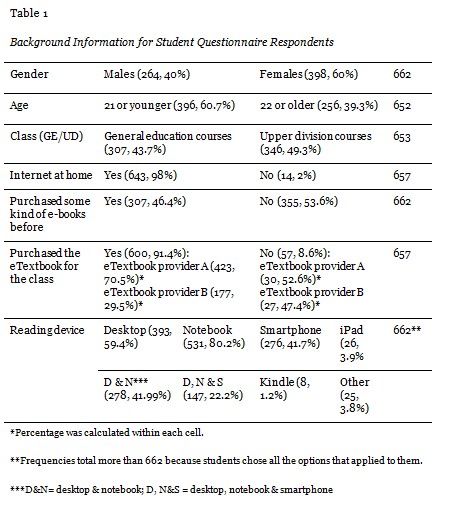
Students’ overall satisfaction regarding the eTextbook was evenly distributed into three groups, satisfied, neutral, and dissatisfied, following the combination of agree and strongly agree responses into one category and disagree and strongly disagree into another. Slightly more than one-third of students (208 of 598 respondents, 34.2%) said that they were satisfied with the eTextbook as compared to students who rated themselves dissatisfied (192, 31.6%) as shown in Figure 1.
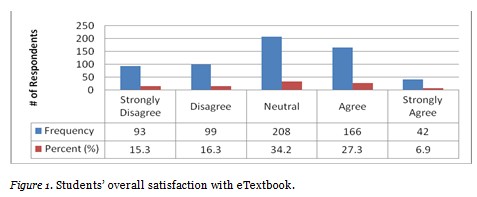
This result is congruent with other studies (BISG, 2011; Student PIRGs 2008, 2010). The Book Industry Study Group’s recent questionnaire study (January 6, 2011) revealed that nearly 75% of student respondents prefer print textbooks due to affection for their look and feel, permanent ownership, and the option to resell. Student PIRGs (2008, 2010) survey studies also mentioned that 75% of students prefer regular print textbooks for their readability, because they are used to them, and because of their convenience. In the National Association of College Stores’ study (2010), 74% of students (627 participants) said that they would choose a printed book over an eTextbook if the choice were left entirely up to them for its permanent ownership and the option to resell. In these studies, only about 25% preferred eTextbooks.
This result is somewhat disappointing as compared to the results of a survey study conducted at campus D by the ALS project team in the spring of 2010 (Baek & Monaghan, 2010a, 2010b). In that questionnaire, 78.46% of students (492 out of 627 returned questionnaires) rated themselves likely to choose this new textbook option. This shows quite a high level of openness and a preference for the licensed eTextbook option, when less than half of the participants were familiar with this option.
One must exercise caution in directly comparing the data as the current data report “satisfaction” while the previous report “preferences.” It is difficult to pinpoint one specific factor that would have influenced this phenomenon. The lower price of the eTextbook was a driving force behind the finding of high interest in eTextbooks (pilot testing results from the spring 2010 data). After using the eTextbook, only one-third of questionnaire respondents had a positive experience. This implies that the low price alone cannot bring students satisfaction with the eTextbook. A myriad of variables (e.g., student variables and eTextbook features) discussed here in the Findings section seem to contribute.
Over 53% (323 of 607) of students who responded to this question said that the eTextbook was easy to use, while 22.1% (134) of students thought it was not easy to use as shown in Figure 2. There was no statistically significant difference in the students’ perceptions toward ease of using the eTextbook between the two eTextbook providers.
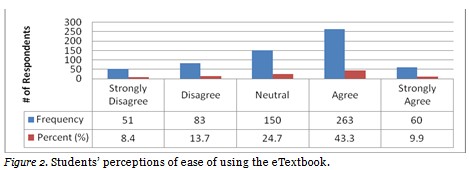
However, there was a statistically significant difference in students’ perceptions of the online version and the downloadable version. As shown in Table 2, students who used an online version were more likely to perceive the process of initially accessing the eTextbook as easy and overall were more likely to rate the eTextbook as easy to use than students who used a downloadable version. In order to read the downloadable version, students had to go through an additional initial step required to access and read the downloadable version which required downloading the textbook company’s application.
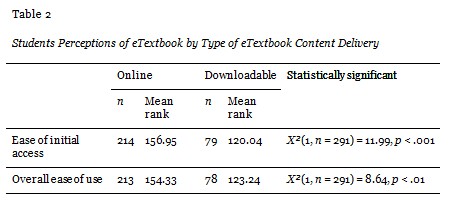
Students were unlikely to say they would use an eTextbook again or recommend one to a friend. However, those students who found the eTextbook easy to use were more likely to say they would use another or recommend one to a friend. Only about 16.7% of students agreed that they are likely to choose a class where the instructor requires them to buy an eTextbook license in the future. More than 49% of students did not agree with that statement.
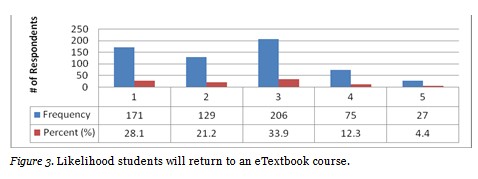
This sentiment was consistent when students were asked whether they would recommend a class that requires purchase of an eTextbook license to a friend. Students who strongly agreed or agreed accounted for 18% (108) of respondents while those who strongly disagreed or disagreed made up 45.6% (275) of 603 respondents as shown in Figure 3. Students’ opinions did not vary significantly based on provider.
This section discusses variables strongly related to students’ perceptions of the eTextbook.
Students’ comfort level reading a long text on a computer screen turned out to be a significant variable that statistically related to students’ overall experience with the eTextbook they used. This variable was revealed as important in the questionnaire conducted in spring 2010 as well (Baek & Monaghan, 2010a, 2010b).
Crosstab (chi-square test) results and Kendall tau b (strength of association) will be discussed below. In the analysis, three categories were used instead of the original five Likert scale items, agree (strongly agree and agree were combined), neutral, and disagree (strongly disagree and disagree were combined), to compare students’ comfort level as the independent variable.
As shown in Table 3, students’ experiences with the eTextbook were significantly different based on whether or not they felt comfortable reading a long text on a computer screen. All of these comparisons were statistically significant at the p < .001 level. All of the relationships between students’ opinions about the eTextbook and their comfort level with reading a long text on a computer screen are positive and most of the strengths of the associations between two variables were mid to large sizes. This means that the more a student believes that s/he has a high level of comfort with reading a long text on a computer screen, the more likely the student is to have favorable opinions about experiences with the eTextbook. In other words, students’ comfort level reading a long text on a computer screen is one of the most important variables to consider in eTextbook implementation as currently construed.

Students’ comfort level using the Internet also statistically correlated to the students’ experience with the eTextbook, however it had a much weaker relationship. Most of the strengths of the association of the variables were small, ranging from .09 to .21.
Students’ perceptions of the eTextbook in the areas of ease of use and willingness to recommend were varied by the individual titles they used in the courses. Students’ perceptions of ease of use were statistically different between individual eTextbooks chosen for each of the courses (X²(21, n = 607) = 64.32, p < .001). There were 22 total textbooks used (each was assigned an individual number for purposes of calculation). As shown in Table 4, eTextbook #9 (Human Resources Management) had the highest mean rank (427.69) while eTextbook #6 (Business Writing) had the lowest mean rank (149.97). Students who used eTextbook #9 perceived the eTextbook as easier to use than the students who used eTextbook #6.
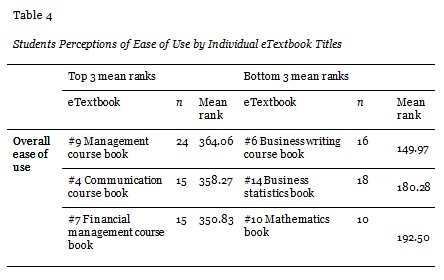
This result seems to be aligned with students’ comments in the open-ended questions, which suggested typing and calculating mathematical/statistical functions and formulae in the eTextbook was not as easy as in the printed book. A similar finding was noted in the Chen, Victorino, Birdsong, Menon, Tseng, and Smith study (2011). College students in a technical engineering course tended to be much less favorable toward the eTextbook than students in more theoretical engineering courses. The researchers inferred that technical difficulties with entering symbolic solutions and user interface influenced students’ perception of the eTextbook they used.
In addition, students’ perceptions about taking an eTextbook required course again (X²(21, n = 606) = 63.95, p < .001) and recommending an eTextbook course to a friend differed depending on the individual eTextbook titles they used, and these results were statistically significant (X²(21, n = 601) = 81.37, p < .001) as shown in Table 5.
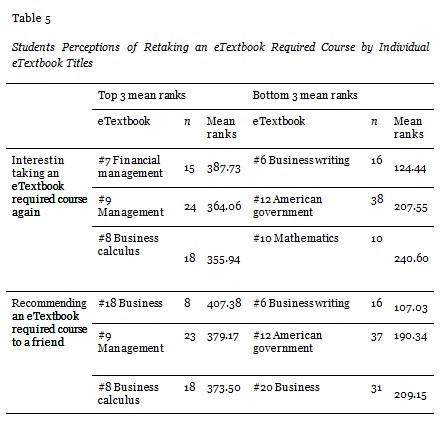
Perhaps most importantly, when students perceived the eTextbook as easy to use, they were more likely to take an eTextbook required course again and to recommend it to their friends. eTextbooks #7 and #9 were highly ranked in terms of ease of use and appeared again at high positions in the taking an eTextbook required course again question. The same principles apply to the lowest ranks; eTextbooks #6 and #10, which were ranked lowest in the category of ease of use, ranked lowest again in the taking an eTextbook required course again variable. eTextbook #6 was the lowest ranked in all three analyses. When students perceived the eTextbook as not easy to use, understandably, they were much less enthusiastic about future opportunities to use an eTextbook and about recommending it to their friends.
This finding is particularly significant and deserves our attention with regard to addressing the usability of eTextbooks including their interface/functional design. In order to increase students’ adoption of an eTextbook and their subsequent positive attitudes toward that eTextbook, providing an eTextbook that is easy to use is crucial.
Most respondents were between 17 and 29 years old (93%, 603), but some were as old as 53. After dividing the students into two age groupings, 21 or younger (396, 60.7%) and 22 or older (256, 39.3%), a Kruskal-Wallis analysis of variance test was used to measure the relationship between students’ experiences with the eTextbook as the dependent variable.
As shown in Table 6, overall, older students’ opinions about, and experience with, the eTextbook were more positive than their younger counterparts’. Most of the differences between the two groups were statistically significant except the three that do not include X² values. This is similar to the finding that students in upper division courses tend to be more satisfied than students in general education courses with an eTextbook.
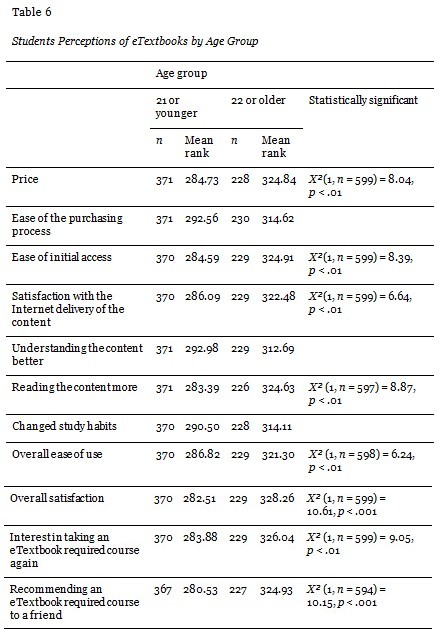
Even though a common general perception exists that younger generations use the Internet more, their focus on social networking and entertainment purposes may alter the impact of that more frequent use on the issues discussed in this study. As McGowan et al. (2009) found, students with more experience using electronic resources as academic resources may transfer their experience and skills to reading the eTextbook. In our study, students in the older group thought the eTextbook was easier to use than the younger group and had higher satisfaction and more positive attitudes toward the eTextbook and its use.
The type of course, general education course versus upper division, also impacted students’ satisfaction with eTextbooks. Students who were enrolled in upper division courses in their majors were more satisfied than students in general education courses. In the Kruskal-Wallis analysis of variance test, there was a statistically significant difference in students’ overall satisfaction depending on the nature of the courses (X²(1, n = 605) = 3.84, p < .05) with a mean rank of 315.76 for the upper division courses and 288.86 for the general education courses. Some students may not be prepared to effectively utilize this technology and need to learn how to utilize the unique features of electronic textbooks before they can fully appreciate them (Petrides, Jimes, Middleton-Detzner, Walling, & Weiss, 2011).
Students’ gender was correlated to students’ willingness to take a course in which an eTextbook was required in the future, as shown in Table 7. This finding is consistent with McGowan et al.’s study (2009). Males were more likely to rate eTextbooks as highly preferred than females. They attributed this to males’ tendency to be visual learners and eTextbooks’ ability to provide a better visual sense than paper version textbooks (McGowan et al., 2009). This may also be related to males’ greater interest in technology as compared to females.
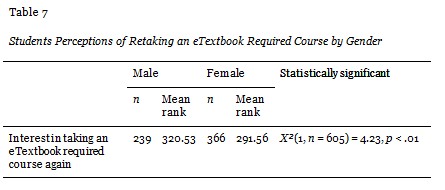
The data on what students most and least liked about the eTextbooks were collected from the open-ended questions in the survey. As shown in Figure 4, 466 students answered questions regarding what they liked best (eTextbook Provider A: 323, 70%; eTextbook Provider B: 143, 30%). Students reported that they most liked the eTextbooks’ price, accessibility/availability to read, light weight, and keyword search feature.
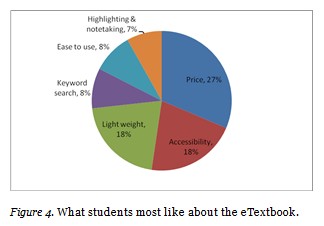
Convincingly, the same results were shown (the exact same four features in almost identical proportions) in a separate analysis grouped by eTextbook provider as shown in Figure 5.
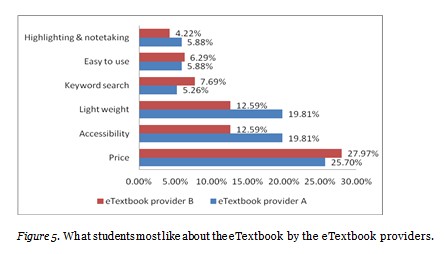
Four hundred and fifty students answered questions regarding the features they liked least about the eTextbook (eTextbook Provider A: 331, 74%, eTextbook Provider B: 119, 26%) as shown in Figure 6. What students least liked about the eTextbook was its low readability (relating to eye-strain and computer reading), limited accessibility, slow loading, lack of resale value, limited highlighting and note-taking features, limited downloading, and the purchasing process. Students chose accessibility/availability to read as their favorite and least favorite things about the eTextbook at the same time. They liked their ability to access the eTextbook anywhere and anytime, but disliked the fact that this is limited to places where the Internet is available.
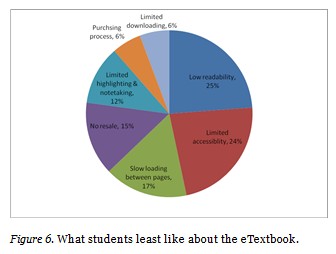
As shown in Figure 7, the seven features students liked least were consistent between groups using eTextbooks from Provider A and Provider B, however the proportions differed. Campuses which used Provider A’s eTextbooks reported greater dissatisfaction with slow loading and the purchasing process.
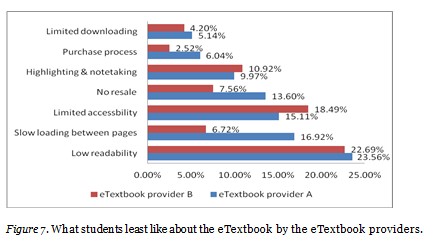
The students’ satisfaction with the process of purchasing the eTextbook was described similarly by the statistical analysis as shown in Table 8. Students’ experience of ease of purchasing the eTextbook did not differ statistically by campus, however it did vary by eTextbook provider.
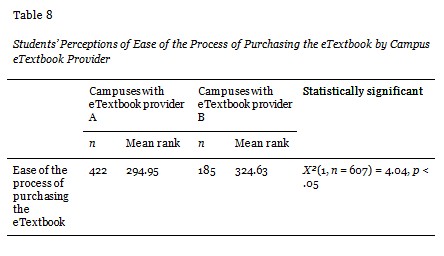
Students at the campuses with eTextbooks from Provider B perceived the purchasing process to be easier than those students at the campuses with eTextbooks from Provider A. This requires cautious interpretation because this seemed to result from various issues related to the purchasing process, such as buying an access code at the bookstore, receiving incorrect codes and so not being able to access the book immediately, and so on, which may be campus specific, rather than issues directly linked to the eTextbook provider itself.
This study demonstrates that eTextbooks must be a high-quality, easy-to-use resource to serve as a viable textbook option for student learning. The easier students perceived the eTextbook was to use, the more willing they were to take a course in which an eTextbook is required in the future or to recommend one to a friend.
Overall student satisfaction with the eTextbook was 34%, a statistic which shows us that there is a long way to go to meet students’ expectations. Even though students liked the eTextbook’s price, price alone cannot be the driving impetus for, or a guarantee of, successful eTextbook implementation.
In order to make students’ experiences more positive, quality material with a user-friendly design must be presented to the students. Several students made it abundantly clear in the open-response questions that having to read the textbook on a computer screen was their least favorite aspect of the eTextbook due to the potential strain on their eyes. Developing an easy-to-use interface may not be a direct answer, but it can definitely alleviate some of students’ apprehensions. As many activity theorists (see Engeström [1987, 1993, 1999a, 1999b, 2000, 2005]; Leont’ev [1978)]; Nardi [1996]) have pointed out, if a new technology intervention fails to serve as a tool to naturally support users’ work/performance it will become an additional object they have to learn.
While making eTextbooks as close to print books as possible in terms of their look and feel, eTextbooks need to differentiate themselves from their print counterparts by harnessing their strengths. For example, students liked the fast one-click keyword search feature that print books do not and cannot offer. Even though it was not included in the list of what students most liked about the eTextbook, many students mentioned in the open-response questions that they liked the extra learning resources the eTextbook offered, such as quizzes with instant feedback, music, video, narration, step-by-step homework guides with feedback, and web links related to the topic. This can help students better understand the content, which contributes to student learning and student satisfaction in positive ways.
Overall, older students were more satisfied with the eTextbook. Students with more experience using electronic resources as academic resources seem to be able to transfer those skills to their interactions with the eTextbook. As result, older students think the eTextbook is easier to use than younger students; they have higher reported satisfaction and more positive attitudes toward use of the eTextbook. Younger students may benefit from a short instructional session with their faculty, discussing some strategies for the effective use of features and components available in the eTextbook. For example, this instruction may include information about how to use homework features and video/audio, how to use highlighting and note-taking features, how to plan ahead to read the eTextbook, how not to be distracted by other Web sites while online, and so on.
Many consider eTextbooks to be one of the most viable solutions to current issues involving college textbooks. In our study the students’ satisfaction rate leaves us with many questions about how the eTextbook licensing option can be improved and what other ways students’ needs can be better met. Instead of focusing on only one solution, other options such as print books (new, used, and rented) and open source textbooks (e.g., flatworldknowlege, http://www.flatworldknowledge.com/, DynamicBooks) as well as textbook financing programs and textbook swap programs need to be considered as well. A more affordable textbook option that allows faculty to customize the content of the book would be a great addition to any solution. eTextbook options may be workable solutions for high demand courses (Florida Department of Education, 2009). System-based educational institutions may consider working with individual campuses to secure a statewide purchasing agreement for eTextbooks, rather than having each campus pursue individual agreements, as a statewide purchasing agreement could result in greater cost-effectiveness.
Successful adoption of eTextbooks by large numbers of students requires a multifaceted approach. Students, faculty, staff, administrators, and eTextbook publishers/providers need to work together to develop high-quality eTextbooks (Student PIRGs, 2008, 2010; Young, 2009, 2010a, 2010b, 2010c). That combined effort will take us closer to an affordable textbook solution.
The current study has only examined the perceptions of students who participated in the survey. There was no mechanism applied to capture students’ perceptions if they did not take part in the survey. Also, this study sampled students who used eTextbooks produced by only two eTextbook providers. Caution must be applied as the findings might not be transferable to students using other eTextbook providers.
Longitudinal studies of how eTextbooks impact students’ perceptions and learning, especially cognitive processes that may be differently affected by textbook formats (print and eTextbooks), would meaningfully contribute to the knowledge base of eTextbooks. These studies may be focused on specific disciplines in conjunction with instructional strategies and different features of eTextbooks and eReader devices.
Advisory Committee on Student Financial Assistance. (2007, May). Turn the page: Making college textbooks more affordable (A report of the Advisory Committee on Student Financial Assistance). Retrieved from http://www2.ed.gov/about/bdscomm/list/acsfa/turnthepage.pdf
Baek, E., & Monaghan, J. (2009, June). Supporting effective location and distribution of digital instructional resources: Needs assessment findings. Paper presented at the meeting of ED-MEDIA 2009 World Conference on Educational Multimedia, Hypermedia & Telecommunications, Honolulu, Hawaii.
Baek, E., & Monaghan, J. (2010a, July). Accessibility, availability, choice: Testing the digital marketplace prototype. Paper presented at the meeting of 3rd Annual Emerging Technologies for Online Learning Symposium, San Jose, CA.
Baek, E., & Monaghan, J. (2010b, November). Are we ready for digital textbooks? Paper presented at the meeting of the EdTech Classroom Conference, San Bernardino, CA.
Book Industry Study Group. (2011). College students want their textbooks in the old-fashioned way: In print landmark research into preferences of college students reveals e-texts lagging far behind print, for now. Retrieved from http://www.bisg.org/news-5-603-press-releasecollege-students-want-their-textbooks-the-old-fashioned-way-in-print.php
California State Auditor. (2008). Affordability of college textbooks: Textbook prices have risen significantly in the last four years, but some strategies may help to control these costs for students. Bureau of State Audits. Retrieved from http://www.bsa.ca.gov/pdfs/reports/2007-116.pdf
Chen, J., Victorino, C., Birdsong, C., Menon, U., Tseng, M., & Smith, T. (2011, June). A study of online textbook use across multiple engineering courses. Paper presented at the meeting of the American Society for Engineering Education Conference, Vancouver, Canada.
Engeström, Y. (1987). Learning by expanding: An activity-theoretical approach to developmental research. Helsinki, Finland: Orienta-Konultit.
Engeström, Y. (1993). Developmental studies of work as a test bench of activity theory: The case of primary care medical practice. In S. Chaiklin & J. Lave (Eds.), Understanding practice: Perspectives on activity and context (pp. 64-103). Cambridge, MA: Cambridge University Press.
Engeström, Y. (1999a). Communication, discourse and activity. The Communication Review, 3(1&2), 165-185.
Engeström, Y. (1999b). Innovative learning in work teams: Analyzing cycles of knowledge creation in practice. In Y. Engeström, R. Miettinen & R. Punamaki (Eds.), Perspectives on activity theory (pp. 377-404). Cambridge, UK: Cambridge University Press.
Engeström, Y. (2000). Comment on Blacker et al. Activity theory and the social construction of knowledge: A story of four umpires. Organization, 7(2), 301-310.
Engeström, Y. (2005). Developmental work research: Expanding activity theory in practice. Berlin: Lehmanns Media.
Flick, U. (1998). An introduction to qualitative research. Thousands Oaks, CA: Sage Publications.
Florida Department of Education. (2009). Textbook affordability workgroup final report. Retrieved from http://www.fldoe.org/cc/pdf/fcstawfr.pdf
Hoseth, A., & McLure, M. (2012). Perspectives on e-books from instructors and students in the social sciences. Reference & User Services Quarterly, 51(3), 278-288.
Leont’ev, A. N. (1978). Activity, consciousness, and personality. Englewood Cliffs: Prentice-Hall.
Lincoln, Y. S., & Guba, E. G. (1985). Naturalistic inquiry. Beverly Hills, CA: Sage Publications.
McGowan, M. K., Stephens, P. R., & West, C. (2009). Students perceptions of electronic textbooks. Issues in Information Systems, 10(2), 459-465.
Nardi, B. (Ed.)(1996). Context and consciousness: Activity theory and human-computer interaction. Cambridge: MIT Press.
National Association of College Bookstores. (2010). Electronic book & e-reader device report (PDF). Retrieved from https://www.nacs.org/LinkClick.aspx?fileticket=blmPMgdQ_LA3d&tabid=2471&mid=3210
Petrides, L., Jimes, C., Middleton-Detzner, C., Walling, J., & Weiss, S. (2011). Open textbook adoption and use: Implications for teachers and learners. Open Learning, 26(1), 39-49. doi:10.1080/02680513.2011.538563
Reynolds, R. (2011). Trends influencing the growth of digital textbooks in US higher education. Publishing Research Quarterly, 27(2), 178-187. doi:10.1007/s12109-011-9216-5
Ritter, M. (2010, December 1). Do students really prefer print textbooks? The Digital Professor. Retrieved from http://thedigitalprofessor.wordpress.com/2010/12/01/do-students-really-prefer-print-textbooks/
Shepperd, J. A., Grace, J. L., & Koch, E. J. (2008). Evaluating the electronic textbook: Is it time to dispense with the paper text? Teaching of Psychology, 35(1), 2-5. doi:10.1080/00986280701818532
Student PIRGs (2008). Course correction: How digital textbooks are off track and how to set them straight. Retrieved from http://www.studentpirgs.org/uploads/0b/9e/0b9e1d998ea89a92839789f43b506988/course-correction.pdf
Student PIRGs (2010). A cover to cover solution: How open textbooks are the path to the textbook affordability. Retrieved from http://www.studentpirgs.org/uploads/66/4d/664d09ba9bc97cc9138eda5faac5e061/A-Cover-To-Cover-Solution.pdf
United States Department of Education. (2008). Higher Education Opportunity Act – 2008. Retrieved from http://frwebgate.access.gpo.gov/cgi-bin/getdoc.cgi?dbname=110_cong_public_laws&docid=f:publ315.110.pdf
United States Government Accountability Office. (2005). College textbooks: Enhanced offerings appear to drive recent price increases. GAO-05-806.
Weisberg, M. (2011). Student attitudes and behaviors towards digital textbooks. Publishing Research Quarterly, 27(2), 188-196. DOI 10.1007/s12109-011-9217-4
West Virginia Higher Education Policy Commission and Community and Technical College System (2009). Final report of the statewide task force on textbook affordability. Retrieved from https://www.wvhepc.org/resources/TTF_Report-Web_Ready072409.pdf
Young, J. R. (2009, September 7). As textbooks go digital, campus bookstores may go bookless. The Chronicle of Higher Education. Retrieved from http://chronicle.com/article/The-Year-of-eTextbooks-/48305/
Young, J. R. (2010a, October 24). To save students money, colleges may force a switch to eTextbooks. The Chronicle of Higher Education. Retrieved from http://chronicle.com/article/The-End-of-theTextbook-as-We/125044/
Young, J. R. (2010b, October 26). Students remain reluctant to try eTextbooks, survey finds. The Chronicle of Higher Education. Retrieved from http://chronicle.com/blogs/wiredcampus/students-remain-reluctant-to-try-eTextbooks-survey-finds/27866
Young, J. R. (2010c, November 14). As textbooks go digital, campus bookstores may go bookless. The Chronicle of Higher Education. Retrieved from http://chronicle.com/article/As-Textbooks-Go-Digital/125363/